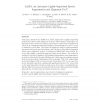CSL
2016
Springer
8 years 10 months ago
2016
Springer
Language transfer creates a challenge for Chinese (L1) speakers in acquiring English (L2) rhythm. This appears to be a widely encountered difficulty among foreign learners of Eng...
CSL
2016
Springer
8 years 10 months ago
2016
Springer
Phonological studies suggest that the typical subword units such as phones or phonemes used in automatic speech recognition systems can be decomposed into a set of features based ...
CSL
2016
Springer
8 years 10 months ago
2016
Springer
This paper describes an optimal algorithm using continuous state Hidden Markov Models for solving the HMS decoding problem, which is the problem of recovering an underlying sequen...
CSL
2016
Springer
8 years 10 months ago
2016
Springer
Hybrid deep neural network–hidden Markov model (DNN-HMM) systems have become the state-of-the-art in automatic speech recognition. In this paper we experiment with DNN-HMM phone...
CSL
2016
Springer
8 years 10 months ago
2016
Springer
This paper describes the ALISA tool, which implements a lightly supervised method for sentence-level alignment of speech with imperfect transcripts. Its intended use is to enable ...




